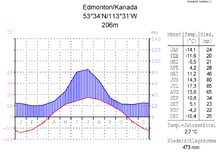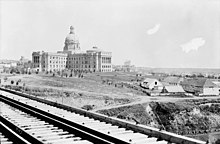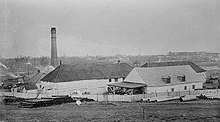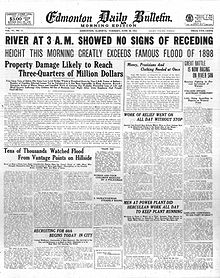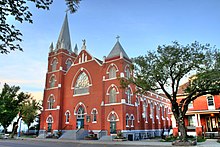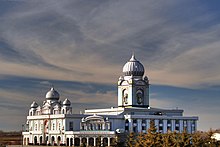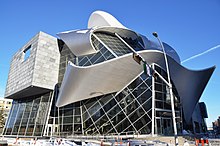Edmonton
| Edmonton | ||
|---|---|---|
 |
||
 coat of arms |
 flag |
|
|
Motto : Industry - Integrity - Progress (diligence - integrity - progress) |
||
| Location in Alberta | ||
|
|
||
| State : |
|
|
| Province : | Alberta | |
| Region: | Edmonton Capital Region | |
| Coordinates : | 53 ° 32 ′ N , 113 ° 30 ′ W | |
| Height : | 668 m | |
| Area : | 684.37 km² | |
|
Inhabitants : - Metropolitan Area : |
932,546 (as of 2016) 1,411,945 (as of 2017) |
|
| Population density : | 1,362.6 inhabitants / km² | |
| Time zone : | Mountain Time ( UTC − 7 ) | |
| Postal code : | T5A - T6Z | |
| Foundation : | 1795 | |
| Mayor : | Don Iveson | |
| Website : | www.edmonton.ca | |
 Edmonton city center |
||
Edmonton [ ˈedməntən ] is the capital of the Canadian province of Alberta . It has 932,546 inhabitants, whereas the metropolitan region (CMA) has 1,411,945 inhabitants (2017). This makes Edmonton the second largest city in the province after Calgary and the fifth largest in Canada. With a total area of 683 km², it is one of the largest cities in North America, but also has a very low population density.
Indian settlements go back at least 11,000 years, but the city dates back to a fort built in 1795. In 1905 Edmonton became the capital of the province, which depended heavily on agriculture until around World War II. War production and natural resources brought the city a long-lasting industrial boom despite the inhospitable climate. The most important branch of the economy today is the service industry, whose largest employer next to the government is the University of Alberta .
geography
Edmonton is located near the geographic center of the Province of Alberta, at an altitude of 668 meters above sea level. The terrain around the city is generally flat to slightly undulating, with canyons and deeply cut river valleys like the valley of the North Saskatchewan River . Although the Rocky Mountains are only about 220 km to the southwest, the mountains are too far away to be seen from the tallest buildings in the city.
The North Saskatchewan River , which has its source at the Columbia Ice Field in Jasper National Park , divides the city in a southwest-northeast direction. It flows over the Saskatchewan River , Lake Winnipeg and the Nelson River into Hudson Bay . In the urban area, numerous streams flow into the river, such as Mill Creek or Whitemud Creek, whose gorges are integrated into parks. Edmonton lies between the prairie to the south and the boreal coniferous forest to the north. The transition zone known as aspen parkland consists of groves with aspen and spruce trees , which are interrupted by open grassland. Agriculture, settlement and the extraction of natural resources have pushed this biosphere back in many places.
Parkland
The Edmonton River Valley consists of the longest contiguous system of urban parks in North America, the River Valley Parks System . The city has the largest park area per capita of any Canadian city. The city parks along the North Saskatchewan River are complemented by numerous parks in various neighborhoods; the total area is 111 km². Within the 74 km² and 48 km long river park system there are eleven lakes, 14 gorges and 22 individual parks. Five of these parks are named after the " Famous Five ".
Edmonton's parkland has one of the world's largest concentrations of healthy American elms , unaffected by the elm disease that has killed most of this species in eastern North America. Banks pines , coastal pines , white spruce , downy birch , aspens , red ash , linden , various poplars and willows as well as ash maples are also widespread. Introduced, non-native tree species include blue spruce , Norway maple , red oak , sugar maple , Horse Chestnut and McIntosh apple tree . Three types of walnut - butternut , Manchurian walnut, and black walnut - have been preserved in Edmonton.
Several golf courses , both public and private, are located in the river valley. Due to the city's location in the far north, these can be played until late in the evening. During the long winter season, winter sports are practiced in the parks and golf courses; cross-country skiing and ice skating are particularly popular . In the river valley there are also four areas for alpine skiing , two of which are in the urban area and two just outside.
City structure
The city center, the Downtown, consists of the commercial center, the Arts District, Rice Howard Way Pedestrian Mall, MacKay Avenue, Jasper-West, the Warehouse District and the government district (Grandin neighborhood).
Around this city center are further parts of the city that are referred to here as neighborhoods, such as Oliver, Glenora, Westmount, Inglewood, Central McDougall, McCauley, Alberta Avenue or Norwood in the north, Windsor Park, Garneau, Old Strathcona, Bonnie Doon south of the river . Riverdale, Rossdale, Walterdale and Cloverdale, which lie in the river valley, fought with partial success against an eviction attempt in the 1970s.
climate
Edmonton lies in the transition area from a cool temperate to cold coniferous forest climate . For this reason there is a relatively dry continental climate with large differences between summer and winter. However, the winters are slightly milder than in the southern cities of Regina and Winnipeg . The average temperature ranges from −11.7 ° C in January to 17.5 ° C in July. On average, the temperatures rise to over 30 ° C three times a year, while they drop to below −20 ° C on 28 days. The highest temperature ever recorded in Edmonton was 34.5 ° C on August 5, 1998. The coldest temperature was −49.4 ° C, measured on January 19 and 21, 1886. The year 2006 was particularly warm when the temperatures rose to over 29 ° C on a total of 20 days between mid-May and early September. As a rule, summer lasts from late June to late August, and winter from November to March. In winter there is usually permafrost, but temperatures can rise above freezing point when warm air flows in from the south. Spring and autumn are short and characterized by changeable weather.
Edmonton's climate is relatively dry. An average of 476.9 mm of precipitation falls per year, of which 365.7 mm is rain and 123.5 cm is snow . Most rainfall occurs in late spring, summer and early autumn. The wettest (and also the hottest) month is July, while February, March, October and November are the driest.
Thunderstorms are common in summer. Occasionally they are severe enough to create hail , storms, funnel clouds, and tornadoes . However, the tornadoes that occur in Edmonton are much weaker and less long-lasting than those further south. F4 tornadoes on the Fujita scale are extremely rare. The last one occurred on July 31, 1987; it killed 27 people, destroyed 300 houses and caused damage totaling Canadian dollars 330 million . A particularly violent thunderstorm, of this magnitude only about every 200 years, occurred on July 11, 2004. Within an hour, 100 mm of rain and hail fell per square meter.
The following table shows the average climate values from 1971 to 2000:
|
Average monthly temperatures and rainfall for Edmonton
|
|||||||||||||||||||||||||||||||||||||||||||||||||||||||||||||||||||||||||||||||||||||||||||||||||||||||||||||||||||||||||||||||||||||||||||||||||||||||||||||||||||||||||||||||||||||||||||||||||||||||||||||||||||||||||||||||||
history
prehistory
When the glacier masses retreated to the north at the end of the Würm Ice Age, a large, shallow lake formed on the exposed land. This emptied within a short time around 12,000 years ago after the moraine on the south bank had eroded. The newly formed North Saskatchewan River made its way through the soft sediments of the former lake and also eroded the layers below. The deeply cut river valley was created within 3000 years.
Around 9000 BC Chr. Human traces can be found in southern Alberta, which indicate nomadic, mainly hunting-based cultures. They may have been bison hunters, which is indicated by finds near Vilna , around 150 km northeast of Edmonton and at James Pass. Finds in the Drayton Valley , 130 km southwest of Edmonton and in the Peace River region indicate a different way of life. Apparently these first inhabitants hunted small horses in addition to other large game, using Clovis- type weapons . This group lived in northern Alberta, e.g. B. at the Vermilion Lakes west of Banff .
It is unclear whether the hunting successes of the Neolithic hunters led to the disappearance of the mammoths and horses, or the drastic climate change. Grasslands and boreal forests spread further north and east in the centuries that followed. Now there was a group of hunters in central Alberta who did not use the lanceolate tips of the south. With the disappearance of the megafauna , especially of the mammoth and mastodon , a specialization began in smaller, but in large herds, on caribou and bison , which they probably pursued for up to 1400 km per year.
Between 7000 and 4000 BC When the south was extremely arid, herds of bison migrated northward, followed by human hunters. A technological innovation, the spear thrower (Atlatl), came around 5000 BC. In use. This increased the range of the hunters, but also their safety. Extensive tailing or early trade is shown in a blade found at Gardiner Lake Narrows near Fort McMurray , from a camp 1,600 miles away in the northwest. Until about 3500 BC A dry, warm phase ensured the greatest expansion of the grassland at the expense of the forests. 3000 BC at the latest Storehouses were built. In these pit houses, bones placed in water were boiled with the help of glowing stones, probably to make pemmican .
Around 2000 BC A new interglacial period began with cooler, wetter winters. Larger herds of buffalo crossed the area again. It is possible that groups from the south pushed the so-called Oxbow people further north. Around 1250 BC BC to AD 500, the first ceremonially significant places called Medicine Wheels are within reach . Some of them are sacred to this day. The Oxbow culture was possibly followed by the Besant culture, which already knew pottery and - around 200 AD - bow and arrow.
Certain types of stone came from Oregon and North Dakota as trade goods , copper came from the Great Lakes region , and jewelry made from shells from the Pacific and even the Gulf of Mexico . The culture of the moundbuilders in Ohio , Dakota, and the upper Mississippi extended to central Alberta. The teeth of grizzly bears or chalcedony were discovered by 100 BC at the latest. Demanded by the comparatively dense populations in the south. This prompted hunters to look for it - a pattern into which the fur traders who later came from Europe easily fitted.
Around 750 ancestors of the Athabascans moved south. A culture of its own with a highly developed pottery emerged in central and southern Alberta. Even at this time, Blackfoot and Cree can be distinguished from one another. Driven hunting techniques, which had been practiced for several millennia, were abandoned between 1600 and 1700, when rifles appeared as hunting weapons and horses appeared at the end of the 17th century.
Foundation and slow growth
It is widely believed that Anthony Henday, an employee of the Hudson's Bay Company (HBC), was the first European to reach the area in 1754. His voyages of discovery through the Canadian prairies were mainly used to find routes for the fur trade and to establish trade contacts with the locals in order to forestall its main competitor, the North West Company (NWC). Until the 1790s, traders and hunters operated from forts further south and lived only seasonally on the North Saskatchewan River.

In 1795 the HBC founded the Edmonton House branch at the confluence of the Sturgeon River in the North Saskatchewan River, near today's Fort Saskatchewan . It was named after the town of Edmonton east of London , the home of HBC Lieutenant Governor Sir James Winter Lake. The HBC branch was in competition with the neighboring Fort Augustus of the NWC. In the first three decades of the 19th century, the HBC relocated its branch several times, which in this way came closer and closer to the location of today's city of Edmonton. The NWC followed suit in order to observe the competition.
In 1801 it was first relocated to the Rossdale area, which is now part of downtown Edmonton. Marie-Anne Gaboury , Louis Riel's grandmother , was the first woman of European descent to settle here in 1807. From 1810 to 1812, both forts were more than 100 kilometers northeast in Smoky Lake . But this location did not prove itself from an economic point of view, so that the forts were rebuilt immediately adjacent in Rossdale on the north bank of the river. Both societies fought from 1815 to 1820 in the so-called Pemmican War , until they were finally united under state coercion. The name Fort Augustus disappeared in favor of Fort Edmonton. After a flood, the fort had to be relocated one last time in 1830. It was newly built in the neighborhood on a slightly elevated plot of land.
George Simpson, the HBC governor responsible for this region, wanted to move the regional headquarters to Fort Assiniboine . But chief agent John Rowand, who was familiar with the local trade routes, convinced him that Fort Edmonton was better suited. For the next 50 or so years, Fort Edmonton was the main HBC location west of Fort Garry (now Winnipeg ). Over time, more and more traders, craftsmen and workers moved here. A small settlement was built around the fort, and from 1838 Catholic and Baptist missionaries also settled there. The most famous resident was the painter Paul Kane , who lived in Fort Edmonton for a few months in 1846/47 and studied the way of life of the Indians. John Palliser toured the area in 1857. His expedition report, which emphasized the good opportunities for agriculture, would lead to a renewed surge of immigration four decades later.
The recurring epidemics such as smallpox and flu were catastrophic for the Indians . They let the fur trade collapse for years because the surviving Indians avoided contact. The Canadian government, which had taken over the land of the HBC in 1869, negotiated the Numbered Treaties from 1871 , with which the Indians were pushed into reservations . At the same time, the mass killing of the buffalo herds deprived them of their livelihoods. In 1862 the Hospice St. Joseph, the first residential school in Alberta , was built on Lac La Biche . These schools served the assimilation of Indian children, similar to the enforcement of rural activity among adults. The American Indian Act of 1876 created the legal framework for this approach. Of the Numbered Treaties for the Edmonton area, No. 6 (Fort Carlton 1876) and No. 8 ( Small Slave Lake , 1899) were of particular importance.
The first census in 1881 counted 263 residents. Since the transcontinental railroad line of the Canadian Pacific Railway (CPR) was built further south via Calgary , the upswing hoped for by traders and speculators did not take place for the time being and the land around Fort Edmonton that had been parceled by the HBC remained unused. In 1891 the Calgary and Edmonton Railway (later a subsidiary of CPR) opened a branch line from Calgary. The line ended but first in Strathcona on the south bank of the river, since the construction of a bridge over the North Saskatchewan River seemed too expensive. As a result, the settlement, which was connected to the train station in Strathcona by a ferry, grew rapidly. In 1892 Edmonton was granted parish status and Matthew McCauley was elected its first mayor.
The railroad laid the foundation for increased immigration, because the settlers' products could now also be marketed in the rest of Canada. Above all, the cattle breeding begun in 1876, which used the same soil that the buffalo herds had grazed, formed the basis of the settlement. The land was divided into one square mile settler sites and between 1901 and 1905 alone, at the height of immigration, 40,000 contracts were signed. In 1911 the original inhabitants, the Indians, Métis and Inuit , no longer made up five percent of the population.
Capital of Alberta
In 1902 the railway finally reached the north bank after the Edmonton, Yukon and Pacific Railway had built the missing bridge. Edmonton already had 8,350 inhabitants in 1904 and received city rights that year. On September 1, 1905, parts of the Northwest Territories formed the new Province of Alberta , with Edmonton as its capital. The decisive factor for Edmonton and against Calgary was the great influence of the first provincial prime minister Alexander Cameron Rutherford and Frank Oliver , the founder of the Edmonton Bulletin newspaper .
When the Calgary & Edmonton Railway reached the south bank of the North Saskatchewan River in 1891, a planned town was created that was to be called South Edmonton . However, the rapidly growing city was annexed to Edmonton in 1899 as the Town of Strathcona with a population of over a thousand. Still, the city continued to grow, especially after the Klondike gold rush began . In 1907 it had 3,500 inhabitants. However, when the Canadian Northern Railway and the Grand Trunk Pacific Railway established their stations and routes in Edmonton in 1905 and 1908, Edmonton quickly outstripped its neighbors. In 1908 Edmonton decided to establish a university in Strathcona. So in Strathcona, which had become an independent municipality in 1899 and a city in 1906, the University of Alberta was founded in 1908 . In 1912 Strathcona merged with Edmonton.
Shortly before the First World War , the real estate boom came to an abrupt end. The population fell within two years from 72,500 to 54,000. The reasons for this were the recruitment of soldiers for the war in Europe and a devastating flood in 1915, which destroyed numerous industrial plants on the riverbank (these were subsequently not rebuilt). HBC closed its branch in 1891, and the fort, which has not been in use since then, was demolished in 1915.
After the end of the war, the population continued to grow slowly. Due to financial problems, not a single public building of any importance was built for years, and the volume of residential construction was very low. In 1929 Blatchford Field Airport (now Edmonton City Center Airport ) began operations. The supply flights to the subarctic and arctic regions, which start from here, strengthened Edmonton's role as the “gateway to the north”. The rapidly growing air freight sector and the lack of large industrial operations meant that Edmonton was far less affected by the effects of the Great Depression than the surrounding rural regions. This was badly affected by extremely dry years (see Dust Bowl ) and plagues of short-lived terrors . There was a rural exodus to the few cities like Edmonton, which in turn caused local wages to fall.
In contrast to the First World War, the population of Edmonton increased significantly during the Second World War , as the army and especially the air force set up large bases and thus created many jobs. Edmonton was also the starting point for the construction of the Alaska Highway and a pipeline to the Norman Wells oil fields on the Mackenzie River . During the war years, numerous US soldiers were stationed here, who at times made up ten percent of the population.
Oil booms and oil crises
On April 13, 1947, Alberta's first significant oil discoveries were made near the town of Leduc , around 30 kilometers south of Edmonton . Although oil was first discovered in the south of the province in 1914 , the amount produced there was relatively low. Further finds followed in the late 1940s and early 1950s 50 km north of Edmonton in Redwater . The provincial government of Prime Minister Ernest Manning now had a multiple of tax revenue due to the license fees for the extraction of mineral resources and invested this in infrastructure projects.
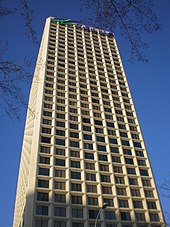
In the mid-1950s, with the construction of pipelines and petrochemical plants, an economic boom began, which resulted in a rapid increase in the population. As early as 1954, Alberta's industry was employing more people than agriculture as a whole, and generating more sales and profits. Edmonton transformed itself from a quiet administrative and university city to a metropolis within a few years. Since there was no central planning authority, the unrestrained and hardly controlled building of houses quickly led to urban sprawl . From 1963 Edmonton International Airport relieved the existing airport. At the end of the 1960s, growth began to slow down as the oil fields reached their maximum production capacity .
The oil crises of 1973 and 1979/80 caused the price of oil to rise many times over. This made the costly exploitation of the Athabasca tar sands in the northeast of the province profitable and Edmonton experienced a second boom. Numerous new infrastructures were built, such as the Edmonton Light Rail Transit light rail or the Commonwealth Stadium , where the Commonwealth Games took place in 1978 , the first major international sporting event in the province. Several skyscrapers with heights of over 100 meters were built in the city center .
The boom came to an abrupt end in 1981 when oil prices fell rapidly and the housing bubble burst. It was not just the oil sector that was affected by the severe recession that followed; Agriculture in the surrounding region also fell into a severe crisis due to falling wheat prices. In addition, the unemployment rate rose several times and several banks went bankrupt. In 1981 the West Edmonton Mall opened, a booming project and then the largest mall in the world. The early 1990s were also marked by a recession and the population stagnated. With rising oil prices, the economy began to recover from 1996 and a new boom phase began at the end of the 20th century, which continues to this day. An increased diversification of the economic sectors contributed to this. The high-tech sector in particular increased, making the city less dependent on the oil market. The planning and construction of several new skyscrapers are an outward sign of the ongoing economic upswing.
population
Demographics
|
Share of “visible minorities” in the population |
|
|---|---|
| ancestry | proportion of |
| Chinese | 6.3% |
| South Asians | 5.3% |
| black | 3.1% |
| Filipinos | 2.5% |
| Arabs | 1.6% |
| Southeast Asians | 1.5% |
| Latinos | 1.2% |
| Korean | 0.5% |
| West Asians | 0.4% |
| Japanese | 0.3% |
| other | 0.2% |
| Multiple answers | 0.7% |
According to the census of May 10, 2011, 812,201 people lived in Edmonton, the population of the entire agglomeration ( census metropolitan area ) was 1,159,869. On April 1, 2012, a census carried out by the city authorities showed 817,498 residents. In the five years between 2006 and 2011 the population of Edmonton increased by 11.2%, that of the agglomeration by 12.1% and that of the entire province by 10.8%. The city's population density was 1,186.8 people / km², compared to 5.7 people / km² for the whole of Alberta.
In mid-2006, 11.9% of Edmonton's population was retired (65 years or older), 1.6% below the national average. The median age was 35.3 years (Canada 37.6 years). People of European descent were by far the largest population group, with the English, Scots, Germans, Irish, Ukrainians and French predominating. 5.3% of the population are attributed to the indigenous people ( First Nations , Métis , Inuit ), the other "visible minorities" 22.9% so called ( visible minority groups , see table at right).
Population development
The following overview shows the development of the population according to the results of the census.
|
|
|
Culture and sights
To the southwest of the city is Fort Edmonton Park , a replica of a Hudson's Bay Company fort and Edmonton's main street from circa 1885. To the west is West Edmonton Mall , one of the largest shopping centers in the world. The Jasper Avenue is the main street in the city center ( downtown ) of Edmonton. Whyte Avenue in the Strathcona district forms a smaller center with historic buildings, small shops and pubs and restaurants that are mostly frequented by students. In the Edmonton area is the Alberta Railway Museum .
architecture
Numerous high-rise buildings shape the image of the city, such as the Bell Tower . The tallest building in the city is the 149-meter-high Epcor Tower , which was completed in 2011. There are many hotels and conference centers along the North Saskatchewan River, as well as extensive parks and park-like facilities.
Many church buildings are often hidden between the streets and high-rise buildings. Old Strathcona, in particular, is considered to be a historic quarter in which closed ensembles from the 19th and first half of the 20th century can be found. The older among the churches were built in the neo-Gothic style or adopted French church designs. The latter are mostly Catholic churches. But other Christian groups such as the Ukrainian Orthodox and the Ukrainian Catholic Church can also be seen in the cityscape.
The ethnic minorities can often be found in the cityscape. With the Nanaksar Gurdwara , the Sikhs built an impressive temple at 1410 Horsehills Road NW.
Museums and galleries
Edmonton has more than 60 museums, galleries, and permanent exhibits. The oldest museum is the chapel built in 1861 by Father Albert Lacombe , a Catholic missionary who was mainly active with the Métis who speak French, but also with Blackfoot and Cree , on St. Vital Avenue in the north-west of the city. Two fort museums, the reconstructed Fort Edmonton Park and the Fort Saskatchewan Museum , as well as a military museum, the Loyal Edmonton Regiment Military Museum and museums on so-called pioneering history, such as the Stony Plain & Parkland Pioneer Museum, await with little more recent artifacts Society (west of Edmonton) and the Strathcona Heritage Museum . The Ukrainian Canadian Archives & Museum of Alberta and the Ukrainian Cultural Heritage Village convey Ukrainian culture . There is also an aviation museum, the Alberta Aviation Museum , two railway museums ( Alberta Railway Museum and Archives and the C&E Railway Museum ), a museum on the history of oil ( Canadian Petroleum Discovery Center ) north of Edmonton, a paleontology museum (Paleontology Museum) ) at the university, as well as a school museum, an agricultural and a technology museum and other exhibition sites.
The city's most important museum, however, is the Royal Alberta Museum , which will be completely rebuilt by 2011 for over $ 200 million. In addition to natural history, his focus is on the history of the First Nations in Alberta and the history since the immigration of Europeans.
One of the most important galleries is the Art Gallery of Alberta , the former Edmonton Art Gallery from 1968. This in turn went back to the Edmonton Museum of Arts from 1924. Erected in 1968 under brutalism and named after the architect Don Bittorf Bittorf Building , the house was rebuilt for 88 million dollars. The architect was Randall Stout from California . The building, which integrated parts of the Bittorf building, reopened on January 31, 2010 with a four-month exhibition on Francisco Goya .
The art of First Nations is the Bearclaw Gallery obligation, which was founded in 1975 by Agnes Bugera, and in the internationally successful artists like Norval Morrisseau have issued. It is located in the Gallery Walk Area , where galleries and more than 300 artists are active around 124th Street west of downtown. It developed from around 1981. Latitude 53 has been active since 1953 , an association of artists who are committed to contemporary culture , contemporary visual culture .
Festivals, theater, music
Edmonton hosts several festivals each year (hence the nickname "The Festival City"). The Works Art & Design Festival from late June to early July features works of art and design by Canadian and international artists. The Edmonton International Street Performer's Festival in mid-July is a major street artist festival with performances by artists from around the world. The most important event in summer is K Days (formerly Klondike Days ). It was originally a fair that took up issues related to the Klondike gold rush. Offered Chuckwagon -race, rides, concerts, trade shows and fireworks. In November, the Canadian Finals Rodeo , one of the most important rodeos in North America , takes place together with an agricultural exhibition .
The Edmonton International Fringe Festival in mid-August is the second largest theater festival in the world after the Edinburgh Festival Fringe . The Edmonton Folk Music Festival is also held in August . The Edmonton Heritage Festival shows the culture of the different immigrant peoples. Other major events include the Free Will Shakespeare Festival ( Shakespeare performances), Duanwu Festival ( Dragon Boat Festival ) and the Edmonton International Film Festival .
Economy and Infrastructure
economy
Edmonton is the economic hub of northern and central Alberta and a major center for the oil and gas industry. Supplier and service companies as well as research institutions complement the production division. Due to the concentration of petrochemical companies, the city has been referred to as the Oil Capital of Canada since the 1940s . With the Athabasca oil sands northeast of the city, Canada has the world's second largest reserves of crude oil after Saudi Arabia (the share is around 15%).
However, the urban economy is significantly less dependent on oil and gas than it was a few decades ago; in fact, it is one of the most diversified in the country. The high-tech sector with major companies such as IBM , Telus , Intuit Canada , BioWare , General Electric and Stantec has a large share in this . There are also important educational and research institutions such as the National Institute for Nanotechnology on the grounds of the University of Alberta .
In the 1970s, Edmonton's rise began to be a major center of the financial services industry . Several companies are now headquartered here, including Canadian Western Bank , ATB Financial and Servus Credit Union (formerly Capital City Savings ). There are also branches of other financial institutions operating in Canada. Well known far beyond Canada is the West Edmonton Mall , which was the largest mall in the world for more than twenty years and is still the largest mall in North America today. Galaxyland , the world's largest indoor amusement park , is integrated into the mall . The company has also Aurora cannabis is based in Edmonton.
The FD i magazine of Financial Times described the economic potential of Edmonton as the best of all North American cities. In a study published in 2007, Edmonton ranked first in the category of cities with a population between 500,000 and 2 million people, ahead of Mississauga , Charlotte , Tijuana and Calgary .
traffic
The CANAMEX Corridor runs through Edmonton . This trade route was defined under the North American Free Trade Agreement and is used for transportation between Canada, the United States and Mexico.
The city is an important starting point for transport links to northern Alberta and northern Canada. The largest and most important airport in the Edmonton metropolitan area is Edmonton International Airport south of the city with scheduled flights to the USA , Mexico , Europe and the Caribbean .
The transcontinental long-distance train The Canadian connects Edmonton to the Canadian rail network in the field of long-distance passenger transport, providing direct train connections in the direction of Jasper - Vancouver and in the direction of Saskatoon - Winnipeg - Toronto . The station is located on the north side of the city center at the now closed City Center Airport. The section over the High Level Bridge , the former main access to the city center, is currently out of order. There are plans to build a high-speed line to Calgary . The provincial government has acquired a land corridor for this purpose and bought land in the city center for a new train station, which would lead to reactivation of the route over the High Level Bridge . Rail freight traffic is handled by the Canadian National Railway , which has a major marshalling yard in Edmonton .
The city's road network is largely grid-shaped. The streets are usually numbered; in north-south direction they are referred to as streets , in west-east direction as avenues . However, within the area that has been built on since the 1950s, the motorways and numerous main roads do not follow the grid system. Important main traffic axes are the Yellowhead Highway from the east to the west border of Alberta and the Alberta Highway 2 (also Queen Elizabeth II Highway) to Calgary. Long-distance buses from Greyhound Canada connect Edmonton with numerous cities.
Local public transport is handled by the Edmonton Transit System (ETS). ETS operates over 150 bus routes, seven of which have trolleybuses . With the exception of Fort Saskatchewan , where ETS also operates the bus service, all lines end at the latest at the city limits. Other municipalities in the agglomeration have their own transport companies. A light rail system , the 12.9 km long Edmonton Light Rail Transit , has been running in a north-south direction since 1978 ; six stations in the city center are underground. The LRT has been extended to the south since 2009, the first construction phase went into operation in April 2009, and in April 2010 a further expansion stage up to Century Park was opened, which increases the total length of the route to 20.3 km; this means that a further 26,000 passengers per day are expected. Overall, the LRT is now supposed to carry 100,000 passengers per day. An extension of the light rail to the Northern Alberta Institute of Technology opened in 2015. The opening of an additional line is currently (2016) planned for 2020.
The Edmonton Radial Railway Society operates museum trams in Fort Edmonton Park and over the High Level Bridge during the summer .
Education
The University of Alberta, founded in 1908, is located in Edmonton . In addition, there are Grant MacEwan University , Concordia University College of Alberta and King's University College and other educational institutions such as St. Stephen's Theological College and Guru Digital Arts College .
As the Strathcona Collegiate Institute , the Old Scona Academic Senior High School was founded in 1908 as one of the first colleges in Alberta. When the university was founded, many events were held in this college.
In addition to the university library, there are college and museum libraries, as well as public libraries. The City of Edmonton Public Library was named Library of the Year as the first Canadian library in 2014 by Library Journal .
One of the Edmonton's high schools is Strathcona High School .
The Alberta Interscience Association was founded in 2009.
media
In 1880, Alberta's first newspaper was published in Edmonton, the Liberal-leaning Edmonton Bulletin , which soon became the voice of the provincial prime minister, Frank Oliver . The paper was unrivaled until 1903 when the Edmonton Journal was founded as a conservative paper. It was bought by the Ontario Southam family for half a million dollars in 1912. Other newspapers also tried their luck, but they were mostly short-lived, like The Capital , which only existed from 1909 to 1915. In 1937, under the government of Premier William Aberhart's Social Credit Party , the Alberta newspapers were to be largely brought under government control, including the Conservative Journal. But this attempt failed at the Supreme Court in March of the following year. The rivalry between the two local papers, the Bulletin and the Journal, lasted until 1951, when the Bulletin went bankrupt. It was not until 1978 that competition emerged again with The Edmonton Sun. In 1980 the journal first printed in color.
The Edmonton Journal, under the direction of John Imrie, opened the first radio station in Edmonton with CJCA on May 1, 1922. The associated station was created in 1921 on the corner of 101 and 100th Avenues on Bellamy Hill.
Today there are two major daily newspapers that are issued and today belong to the same media group: the Edmonton Journal and The Edmonton Sun . Other weekly newspapers are the Metro and Vue Weekly , as well as the Edmonton Examinier .
Sports
Edmonton has an ice hockey team in the National Hockey League , the Edmonton Oilers , and a Canadian football team in the Canadian Football League , the Edmonton Eskimos . Since the 2007/08 season there is also a junior ice hockey team in Edmonton with the Edmonton Oil Kings from the Western Hockey League . The city's best-known football club is Edmonton FC , which plays in the North American Soccer League .
Between 2005 and 2012 the Edmonton Indy took place at the Edmonton City Center Airport .
Because of the many successes of the Oilers ( Stanley Cup Champion 1984, 1985, 1987, 1988 and 1990) and the Eskimos (13 times Gray Cup Champion, 5 times in a row from 1978 to 1982) Edmonton is also called the City of Champions .
The Commonwealth Stadium , built on the occasion of the Commonwealth Games 1978 , is primarily used by the Edmonton Eskimos, but is also the venue for many other major events, such as B. the 2001 World Athletics Championships . Many of the Canadian national soccer team's games also take place here.
Town twinning
-
 Gatineau , Canada, since 1967
Gatineau , Canada, since 1967 -
 Harbin , People's Republic of China, since 1985
Harbin , People's Republic of China, since 1985 -
 Nashville , United States, since 1990
Nashville , United States, since 1990 -
 Wonju , South Korea, since 1998
Wonju , South Korea, since 1998 -
 Bergen op Zoom , Netherlands, since 2013
Bergen op Zoom , Netherlands, since 2013
Personalities
See also
literature
- Olga Chorny: Edmonton: A City in Transition , Edmonton: Choralin Enterprises 1987
- Robert S. Kidd: Archaeological Investigations at the Probable Site of the First Fort Edmonton or Fort Augustus, 1795 to Early 1800s , Calgary 1987
- Heinz W. Pyszczyk : Archeology Guide and Tour of Greater Edmonton Area , The Provincial Museum of Alberta, Edmonton, and Strathcona Archaeological Society, Edmonton 1996
Web links
- Edmonton ( English, French ) In: The Canadian Encyclopedia .
- Municipality of Edmonton (English)
- Commercial and business portal Edmonton (English)
- History of the City of Edmonton (English)
- Edmonton Public Library Portal ( June 17, 2008 memento on Internet Archive )
swell
- ↑ a b c d 2011 Census Profile: Edomonton. statcan.ca, accessed August 8, 2012 .
- ↑ Metropolitan Regions (Canada): Provinces and Territories & Metropolitan Regions - Population Statistics, Charts and Map. Retrieved September 1, 2018 .
- ↑ River Valley ( April 23, 2007 memento on the Internet Archive ) - Edmonton City Council
- ↑ uglans sp. (Butternut / Walnut) ( September 21, 2007 memento on the Internet Archive ) - Government of Alberta, Agriculture and Rural Development (2007)
- ↑ a b c d Canadian Climate Normals 1971–2001: Edmonton City Center Airport - National Climate Data and Information Archive, Environment Canada (2004)
- ↑ Climate Date Almanac for January 19 ( Memento of July 29, 2012 in the Internet Archive ) - Environment Canada (2004)
- ↑ Infofile Detail - Edmonton - Tornado ( Memento from June 24, 2015 in the Internet Archive ) in the Edmonton Public Library (English)
- ^ Atlas of the Edmonton tornado and hailstorm: A decade of research - University of Alberta (1997)
- ↑ Edmonton Extreme Precipitation Event July 11, 2004. Archived from the original on March 30, 2009 ; accessed on March 11, 2011 (last available version from March 30, 2009 in the Internet Archive ).
- ^ Before the fur trade - Edmonton History
- ↑ See Royal Alberta Museum: Archeology: Research: James Pass, 2006 ( Memento of March 28, 2009 in the Internet Archive ).
- ↑ Daryl W. Fedje, James M. White, Michael C. Wilson, D. Erle Nelson, John S. Vogel and John R. Southon: Vermilion Lakes Site: Adaptations and Environments in the Canadian Rockies during the Latest Pleistocene and Early Holocene , in: American Antiquity 60/1 (1995) 81-108.
- ^ Daniel S. Amick, Regional Patterns of Folsom Mobility in the American Southwest, in: World Archeology: Hunter-Gatherer Land Use, Ed. Peter Rowley-Conwy 23 (1996), p. 419.
- ↑ See What is a Medicine Wheel? Article on the website of the Royal Alberta Museum ( Memento of the original from April 9, 2018 in the Internet Archive ) Info: The archive link was inserted automatically and has not yet been checked. Please check the original and archive link according to the instructions and then remove this notice. Retrieved April 8, 2018
- ^ A b c d Fur trade hub 1795–1869 - Edmonton History
- ↑ From this treaty in Alberta were the tribes of the Alexander, the Alexis Nakota Sioux, the Beaver Lake Cree Nation, the Cold Lake, the Enoch Cree Nation, the Ermineskin Tribe, the Frog Lake, Heart Lake, Kehewin Cree Nation, the Louis Bull , Montana, O'Chiese, Paul, Saddle Lake, Samson, Sunchild and Whitefish Lake affected.
- ↑ Years of optimism and uncertainty 1869-1891 - Edmonton History
- ^ A brief history of Alberta's Railways - The Alberta Railway Museum. Retrieved April 8, 2018
- ^ See Agriculture in Alberta: The History of Agriculture in Alberta, 2002. Retrieved April 8, 2018
- ^ A b Railways, business, and politics 1891-1913 - Edmonton History
- ^ A b War and Depression 1913-1939 - Edmonton History
- ↑ a b c War and oil 1939-1972 - Edmonton History
- ↑ On this phase of the raw material boom cf. Post-Leduc Oil and Gas Exploration and Development ( September 28, 2013 memento in the Internet Archive ), a contribution from the University of Calgary, 1997.
- ^ A b Riding the roller coaster 1973-2004 - Edmonton History
- ^ A b 2006 Community Profiles: Edmonton. statcan.ca, accessed August 8, 2012 .
- ^ A b Municipal Census Results. edmonton.ca, accessed August 7, 2012 .
- ^ City of Edmonton population, historical. (PDF; 60 kB) edmonton.ca, accessed on August 8, 2012 .
- ^ Father Lacombe Chapel. Retrieved April 8, 2018
- ↑ Bearclaw Gallery
- ^ Gallery Walk Association of Edmonton ( Memento August 20, 2007 in the Internet Archive )
- ↑ Tony Clarke, Bruce Campbell, Gordon Laxer: US oil addiction could make us sick ( Memento June 22, 2007 in the Internet Archive ) - The Parkland Institute, 2006
- ^ Oil Sands Facts ( Memento of March 29, 2008 in the Internet Archive ), Alberta Energy, 2007
- ↑ Greater Edmonton Economic Outlook 2007 ( Memento of the original dated February 22, 2014 in the Internet Archive ) Info: The archive link was inserted automatically and has not yet been checked. Please check the original and archive link according to the instructions and then remove this notice. , Edmonton Economic Development Corporation, June 2007. Content no longer available online (as of April 8, 2018)
- ^ North American Cities of the Future - 2007 fDi magazine award ( Memento of May 24, 2008 in the Internet Archive ), Global Direct Investment Solutions, April 2007
- ↑ Land bought for rail terminal ( Memento of December 18, 2007 on the Internet Archive ), Calgary Herald, April 18, 2007
- ^ Edmonton South LRT Extension opens , in: Railway Gazette, April 26, 2010 .
- ^ Edmonton Radial Railway Society
- ^ The Strathcona Collegiate Institute, Alberta Register of Historic Places
- ^ Library Journal . 2014 Gale / LJ Library of the Year: Edmonton Public Library, Transformed by Teamwork. Retrieved February 10, 2015.
- ^ Historical Information, in Edmonton Journal





